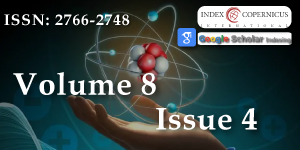The Second Law of Thermodynamics in Irreversible Isothermal Processes
Main Article Content
Abstract
Isothermal irreversible processes under electromagnetic radiation are considered by the “black box” method. The laws of efficiency of conversion of electromagnetic radiation energy into Helmholtz free energy are obtained. The origin of the «white spots» of modern knowledge in various fields of science is explained, which ensures their elimination.
Article Details
Copyright (c) 2025 Petrovna CY.

This work is licensed under a Creative Commons Attribution 4.0 International License.
1. Wien W. Temperature and entropy of radiation. Ann Phys (Berl). 1894;288(5):132-165. Available from: https://doi.org/10.1002/andp.18942880511
2. Planck M. The theory of heat radiation. Philadelphia: Blakiston; 1914. Available from: https://gutenberg.org/files/40030/40030-pdf.pdf
3. Einstein A. On a heuristic point of view concerning the production and transformation of light. Ann Phys (Berl). 1905;322:132-148. Available from: https://doi.org/10.1002/andp.19053220607
4. Landau L. On the thermodynamics of photoluminescence. J Phys USSR. 1946;10:503.
5. Weinstein MA. Thermodynamic limitation on the conversion of heat into light. J Opt Soc Am. 1960;50(6):597-602. Available from: https://doi.org/10.1364/JOSA.50.000597
6. Landsberg PT, Evans DA. Thermodynamic limits for some light-producing devices. Phys Rev. 1968;166(2):242. Available from: https://doi.org/10.1103/PhysRev.166.242
7. Landsberg PT, Tonge G. Thermodynamic energy conversion efficiencies. J Appl Phys. 1980;51(7):R1-R20. Available from: https://doi.org/10.1063/1.328187
8. Chukova YuP. Thermodynamic limit of the luminescence efficiency. Lett J Tech Phys. 1969;10:458-460.
9. Chukova YP. The region of thermodynamic admissibility of light efficiencies larger than unity. Zh Eksp Teor Fiz. 1975;68:1234-1240. Available from: http://www.jetp.ras.ru/cgi-bin/dn/e_041_04_0613.pdf
10. Chukova YuP. On the ultimate efficiency of converting light energy into chemical energy. High Energy Chem. 1977;11(2):126-130.
11. Rosen P. Entropy of radiation. Phys Rev. 1954;96(3):555. Available from: https://doi.org/10.1103/PhysRev.96.555
12. Ore A. Entropy of radiation. Phys Rev. 1955;98(4):887. Available from: https://doi.org/10.1103/PhysRev.98.887
13. Fechner GT. Elements of psychophysics. Vol. 2. Leipzig: Breitkopf und Härtel; 1860. Available from: https://archive.org/details/elementederpsych001fech/page/n7/mode/2up
14. Stevens SS. To honor Fechner and repeal his law: A power function, not a log function, describes the operating characteristic of a sensory system. Science. 1961;133(3446):80-86. Available from: https://doi.org/10.1126/science.133.3446.80
15. Chukova YuP. On the spectral sensitivity of the human eye. Dokl Akad Nauk SSSR. 1988;300(2):504-507.
16. Chukova YP. The Weber-Fechner law. To the 150th anniversary of the publication of the book "Elemente der Psychophysik” by G.T. Fechner. Moscow; 2010.
17. Prigogine I. Time, irreversibility and structure. In: Mehra J, editor. The physicist’s conception of nature. Dordrecht: Springer Netherlands; 1973. p. 561-593. Available from: https://philpapers.org/rec/PRITIA-4
18. Onsager L. Reciprocal relations in irreversible processes. I. Phys Rev. 1931;37(4):405. Available from: https://doi.org/10.1103/PhysRev.37.405
19. Chukova YuP. Features of the bioresponse under the influence of electromagnetic radiation of the radio range. Dokl Akad Nauk SSSR. 1990;311(2):506-508.
20. Chukova YuP. Unexpected relationship: Thermodynamic consideration of some photoprocesses. Moscow: Znanie; 1991. No. 4. (Physics Series).
21. Chukova YP. Advances in nonequilibrium thermodynamics of the systems under electromagnetic radiation. Moscow: Academy of Sciences; 2001.
22. Chukova YP. Introduction to quantum thermodynamics of irreversible isothermal processes. Moscow (Russia): Megapolis; 2018. Available from: https://market.yandex.ru/product--vvedenie-v-kvantovuiu-termodinamiku-neobratimykh-izotermicheskikh-protsessov/1781387083?sku=836840923&uniqueId=7450942&do-waremd5=p-C103xG_cupA5U1NfBKnQ
23. Gusev MV, Nikitina KA. Cyanobacteria: (Physiology and metabolism). Moscow: Science; 1979. Available from: https://rusneb.ru/catalog/002178_000020_BGUNB-BEL%7C%7C%7CBIBL%7C%7C%7C0000401778/
24. Wolken JJ. Photobiology. New York, London: Academic Press; 1968.
25. Wolken JJ. Euglena. New Brunswick: Rutgers University; 1961.
26. Diehn B, Tollin G. Phototaxis in Euglena—II. Physical factors determining the rate of phototactic response. Photochem Photobiol. 1966;5(7):523-532. Available from: https://doi.org/10.1111/j.1751-1097.1966.tb09842.x
27. Rzhanov AV, Chukova YP. Limiting energy characteristics of direct conversion of solar radiation. Dokl Akad Nauk SSSR. 1984;276(6):1385-1388. Available from: https://www.osti.gov/etdeweb/biblio/6283863
28. Nultsch W. The influence of light on the movement of cyanophyceae: I. Report Photo Topo taxis of Phormidium autumnale. Planta. 1961;56:632-647. Available from: https://link.springer.com/article/10.1007/BF01928208
29. Nultsch W. The influence of light on the movement of cyanophyceae: Part II: Photokinesis in Phormidium autumnale. Planta. 1962;57:613-623. Available from: https://link.springer.com/article/10.1007/BF01930343
30. Nultsch W. The influence of light on the movement of cyanophyceae: Part III: Photophobotaxis of Phormidium uncinatum. Planta. 1962;58:647-663. Available from: https://link.springer.com/article/10.1007/BF01914754
31. Chukova YP. Bose condensation and non-thermal processes in living systems under millimeter (MM) radiation. Electromagn Biol Med. 2009;28(1):41-45. Available from: https://doi.org/10.1080/15368370802708355
32. Chukova YP. Reasons of poor replicability of nonthermal bioeffects by millimeter waves. Bioelectrochem Bioenerget. 1999;48(2):349-353. Available from: https://doi.org/10.1016/S0302-4598(99)00034-3
33. Chukova YP. Interactions of science, technology and medicine: Electromagnetic radiation during the twentieth century. In: A Bridge between Conceptual Frameworks: Sciences, Society and Technology Studies. Springer; 2015. p. 85-111. Available from: https://link.springer.com/chapter/10.1007/978-94-017-9645-3_6
34. Southwood TRE. Entomology and mankind: Insects over the ages have greatly affected man’s health and food supply and have played an important role as religious and cultural symbols. Am Sci. 1977;65(1):30-39. Available from: https://www.jstor.org/stable/27847640
35. Chukova YuP. Energy laws of the biosphere as a basis for predicting the fate of our civilization. Russ J Biol Phys Chem. 2021;6(1):26-34.





